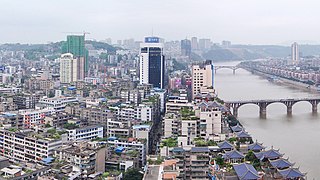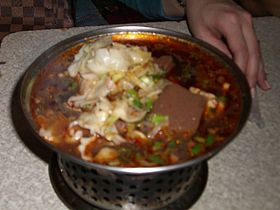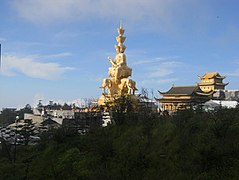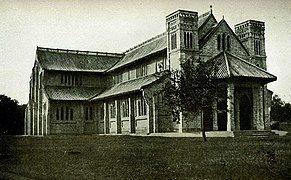
Sichuan cuisine, alternatively romanized as Szechwan cuisine or Szechuan cuisine, is a style of Chinese cuisine originating from Sichuan Province. It has bold flavours, particularly the pungency and spiciness resulting from liberal use of garlic and chili peppers, as well as the unique flavour of Sichuan pepper. Some examples are Kung Pao chicken and Yuxiang shredded pork. There are many local variations within Sichuan Province and the neighbouring Chongqing Municipality, which was part of Sichuan Province until 1997. Four sub-styles of Sichuan cuisine include Chongqing, Chengdu, Zigong and Buddhist vegetarian style.

Sichuan is a province in Southwest China occupying most of the Sichuan Basin and the easternmost part of the Tibetan Plateau between the Jinsha River on the west, the Daba Mountains in the north and the Yungui Plateau to the south. Sichuan's capital city is Chengdu. The population of Sichuan stands at 83 million. Sichuan neighbors Qinghai to the northwest, Gansu to the north, Shaanxi to the northeast, Chongqing to the east, Guizhou to the southeast, Yunnan to the south, and the Tibet Autonomous Region to the west.

The Sichuan Basin, formerly transliterated as the Szechwan Basin, sometimes called the Red Basin, is a lowland region in southwestern China. It is surrounded by mountains on all sides and is drained by the upper Yangtze River and its tributaries. The basin is anchored by Chengdu, the capital of Sichuan province, in the west, and the direct-administered municipality of Chongqing in the east. Due to its relative flatness and fertile soils, it is able to support a population of more than 100 million. In addition to being a dominant geographical feature of the region, the Sichuan Basin also constitutes a cultural sphere that is distinguished by its own unique customs, cuisine and dialects. It is famous for its rice cultivation and is often considered the breadbasket of China. In the 21st century its industrial base is expanding with growth in the high-tech, aerospace, and petroleum industries.

Luzhou (simplified Chinese: 泸州; traditional Chinese: 瀘州; pinyin: Lúzhōu; Sichuanese Pinyin: Nu2zou1; Luzhou dialect: [nu˨˩tsəu˥]), formerly transliterated as Lu-chou or Luchow, is a prefecture-level city located in the southeast of Sichuan Province, China. The city, named Jiangyang until the Southern and Northern Dynasties, is known as the "Liquor City" (酒城). Situated at the confluence of the Tuo River and the Yangtze River, Luzhou is not only an important port on the Yangtze river, but also the largest port in both size and output in Sichuan province since Chongqing was separated from Sichuan province in 1997. As of the 2020 Chinese census, its population was 4,254,149 inhabitants whom 1,241,273 lived in the built-up (or metro) area made of Jiangyang and Longmatan districts, as Naxi district is not conurbated yet. Luzhou, which borders Yunnan, Guizhou and Chongqing, is the only geographic junction of the four provinces, and was therefore the logical place for a port in ancient China. After the PRC was founded in 1949, Luzhou became the capital of southern Sichuan province. In 1983, Luzhou was approved as a prefecture-level city administratively.

The Tea Horse Road or Chamadao, now generally referred to as the Ancient Tea Horse Road or Chamagudao was a network of caravan paths winding through the mountains of Sichuan, Yunnan and Tibet in Southwest China. This was also a tea trade route. It is also sometimes referred to as the Southern Silk Road or Southwest Silk Road.

Sichuanese or Szechwanese (simplified Chinese: 四川话; traditional Chinese: 四川話; Sichuanese Pinyin: Si4cuan1hua4; pinyin: Sìchuānhuà; Wade–Giles: Szŭ4-ch'uan1-hua4), also called Sichuanese/Szechwanese Mandarin (simplified Chinese: 四川官话; traditional Chinese: 四川官話; pinyin: Sìchuān Guānhuà) is a branch of Southwestern Mandarin spoken mainly in Sichuan and Chongqing, which was part of Sichuan Province until 1997, and the adjacent regions of their neighboring provinces, such as Hubei, Guizhou, Yunnan, Hunan and Shaanxi. Although "Sichuanese" is often synonymous with the Chengdu-Chongqing dialect, there is still a great amount of diversity among the Sichuanese dialects, some of which are mutually unintelligible with each other. In addition, because Sichuanese is the lingua franca in Sichuan, Chongqing and part of Tibet, it is also used by many Tibetan, Yi, Qiang and other ethnic minority groups as a second language.

Southwestern Mandarin, also known as Upper Yangtze Mandarin, is a Mandarin Chinese language spoken in much of Southwest China, including in Sichuan, Yunnan, Chongqing, Guizhou, most parts of Hubei, the northwestern part of Hunan, the northern part of Guangxi and some southern parts of Shaanxi and Gansu.
Sichuanese, Szechuanese or Szechwanese may refer to something of, from, or related to the Chinese province and region of Sichuan (Szechwan/Szechuan), especially:

The Minjiang dialect is a branch of Sichuanese, spoken mainly in the Min River (Mínjiāng) valley or along the Yangtze in the southern and western parts of the Sichuan Basin in China. There is also a language island of the Minjiang dialect located in the center of the Sichuan Basin covering several counties, including all of Xichong, Yanting, and Shehong Counties, and part of Jiange, Cangxi, Nanbu, Langzhong and Bazhong. The Minjiang dialect is also referred to as the Nanlu dialect by some scholars.
Ba–Shu Chinese (Chinese: 巴蜀語; pinyin: Bāshǔyǔ; Wade–Giles: Ba1 Shu3 Yü3; Sichuanese Pinyin: Ba¹su²yu³; IPA: [pa˥su˨˩y˥˧]), or Old Sichuanese (or Old Szechwanese; Chinese: 蜀語), is an extinct Sinitic language formerly spoken in what is now Sichuan and Chongqing, China. This language is first attested in Fangyan during the Western Han dynasty (206 BCE–8 CE) and represents one of the earliest splits from Old Chinese or Early Middle Chinese. It started to disappear during the late South Song dynasty period due to the Mongolian conquest which resulted in a massacre throughout the Sichuan Basin. At that time the language was supplanted by Southwestern Mandarin after settlement by people from other parts of China, mostly from present-day Hubei and Hunan.

Christianity is a minority in the Chinese province of Sichuan. Eastern Lipo, Kadu people and A-Hmao are ethnic groups present in the province.

The Sichuanese, Sze Chuan or Ssu Ch'uan people (Chinese: 四川人; Sichuanese Pinyin: Si4cuan1ren2; Mandarin Chinese pinyin: Sìchuānrén; Wade–Giles: Szŭ4-ch'uan1-jen2, 川人 or 川渝人) are a Han Chinese subgroup comprising most of the population of China's Sichuan province and Chongqing municipality.

Chengdu-Chongqing dialect or Cheng–Yu is the most widely used branch of Southwestern Mandarin, with about 90 million speakers. It is named after Chengdu, the capital city of Sichuan, and Chongqing, which was split from Sichuan in 1997. It is spoken mainly in northern and eastern Sichuan, the northeastern part of the Chengdu Plain, several cities or counties in southwestern Sichuan, southern Shaanxi and western Hubei.
Ru Long was a Chinese translator and professor.

Chongqing noodles is a term for a variety of spicy noodle dishes that originated and exist in Chongqing, China, which are collectively referred to as xiǎomiàn, literally "little noodles" in English. Xiao mian is also prepared in other areas of the world, such as the United Kingdom and areas of Australia and the United States.

Sichuan embroidery or Shu embroidery, is a style of embroidery folk art native to Sichuan and Chongqing. It originates from Chengdu, the capital of Sichuan. Sichuan embroidery is one of the well-known "four great embroideries of China" along with Cantonese embroidery, Suzhou embroidery and Xiang embroidery. It is based on the use of coloured silk and satin cloth. It is marked by its even stitching and subtle colours. The general closeness of the stitches allows for embroidering intricate details. It is used to decorate pillow cases, shoes, quilt covers, garments, and screens.

Anglicanism in Sichuan refers to the history and implantation of Anglicanism in the Chinese province of Sichuan. Anglicanism, along with Methodism, were the two largest Protestant denominations in that province.
An Account of the Entry of the Catholic Religion into Sichuan, also referred to as Mission to Sichuan, is a 1918 history book edited by Paris Foreign Missions Society missionary François-Marie-Joseph Gourdon in Chinese, and published by Sheng Chia Book-Printing Bureau in the city of Chongqing.

The presence of the Catholic Church in the Chinese province of Sichuan dates back to 1640, when two missionaries, Lodovico Buglio and Gabriel de Magalhães, through Jesuit China missions, entered the province and spent much of the 1640s doing evangelism.
































